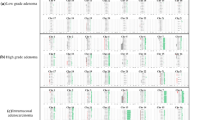Abstract
Patient and methods
A 68-year-old woman presenting with bloody stools and anemia was referred to our hospital. Colonoscopy showed a Is-type tumor of 45 mm in diameter in the cecum and three Is-type tumors in the ascending colon. Ileocecal resection with regional lymph node dissection was performed. Microscopically, the large tumor consisted of a well-differentiated adenocarcinoma with a tubulovillous adenoma (TVA) component (carcinoma in adenoma). Some carcinoma (CA) cells had invaded the submucosal layer, but the lymph nodes were negative for malignancy. The other three polyps were diagnosed as TVAs. Because her family history fulfilled the Amsterdam criteria II for hereditary non-polyposis colorectal cancer (HNPCC), genetic analysis was performed. All of the four tumor tissues were classified as microsatellite stable (MSS) according to the National Cancer Institute guideline for analysis of microsatellite instability (MSI). K-ras mutation was detected in both CA and TVA lesions of the carcinoma in adenoma. To clarify relevant alterations of gene expression associated with adenoma–carcinoma progression, the gene expression profiles of these tumor tissues were analyzed by a cDNA array.
Results
Although the gene expression profiles were similar, insulin-like growth factor-II (IGF-II) was expressed most differentially in CA and TVA tissues. The results were further substantiated by comparison of the gene expression profiles of CA and TVA lesions of the carcinoma in adenoma.
Conclusion
The results suggest that overexpression of IGF-II played an important role in the progression of adenoma to carcinoma in this patient.




Similar content being viewed by others
References
Vogelstein B, Fearon ER, Hamilton SR, Kern SE, Preisinger AC, Leppert M, Nakamura Y, White R, Smits AM, Bos JL (1998) Genetic alterations during colorectal-tumor development. N Engl J Med 319:525–532
Yamamoto H, Imsumran A, Fukushima H, Adachi Y, Min Y, Iku S, Horiuchi S, Yoshida M, Shimada K, Sasaki S, Itoh F, Endo T, Imai K (2002) Analysis of gene expression of human colorectal cancer tissues by cDNA array. J Gastroenterol 37:83–86
Japanese Society for Cancer of the Colon and Rectum (1997) Japanese classification of colorectal carcinoma, 1st English edn. Kanehara, Tokyo, p 70
Kudo S, Rubio CA, Teixeira CR, Kashida H, Kogure E (2001) Pit pattern in colorectal neoplasia: endoscopic magnifying view. Endoscopy 33:367–373
Boland CR, Thibodeau SN, Srivastava S, Sidransky D, Eshleman JR, Burt RW, Meltzer SJ, Rodriguez-Bigas MA, Fodde R, Ranzani GN, Srivastava S (1998) A National Cancer Institute workshop on microsatellite instability for cancer detection and familial predisposition: development of international criteria for the determination of microsatellite instability in colorectal cancer. Cancer Res 58:5248–5257
Notterman DA, Alon U, Sierk AJ, Levine AJ (2001) Transcriptional gene expression profiles of colorectal adenoma, adenocarcinoma, and normal tissue examined by oligonucleotide arrays. Cancer Res 61:3124–3130
Lin YM, Furukawa Y, Tsunoda T, Yue CT, Yang KC, Nakamura Y (2002) Molecular diagnosis of colorectal tumors by expression profiles of 50 genes expressed differentially in adenomas and carcinomas. Oncogene 21:4120–4128
Tricoli JV, Rall LB, Karakousis CP, Herrera L, Petrelli NJ, Bell GI, Shows TB (1986) Enhanced levels of insulin-like growth factor messenger RNA in human colon carcinomas and liposarcomas. Cancer Res 46:6169–6173
Lambert S, Vivario J, Boniver J, Gol-Winkler R (1990) Abnormal expression and structural modification of the insulin-like growth-factor-II gene in human colorectal tumors. Int J Cancer 46:405–410
Michell NP, Langman MJ, Eggo MC (1997) Insulin-like growth factors and their binding proteins in human colonocytes: preferential degradation of insulin-like growth factor binding protein 2 in colonic cancers. Br J Cancer 76:60–66
Freier S, Weiss O, Eran M, Flyvbjerg A, Dahan R, Nephesh I, Safra T, Shiloni E, Raz I (1999) Expression of the insulin-like growth factors and their receptors in adenocarcinoma of the colon. Gut 44:704–708
Takano Y, Shiota G, Kawasaki H (2000) Analysis of genomic imprinting of insulin-like growth factor 2 in colorectal cancer. Oncology 59:210–216
Author information
Authors and Affiliations
Corresponding author
Rights and permissions
About this article
Cite this article
Nosho, K., Yamamoto, H., Takamaru, H. et al. A case of colorectal carcinoma in adenoma analyzed by a cDNA array. Int J Colorectal Dis 20, 287–291 (2005). https://doi.org/10.1007/s00384-004-0656-7
Accepted:
Published:
Issue Date:
DOI: https://doi.org/10.1007/s00384-004-0656-7




